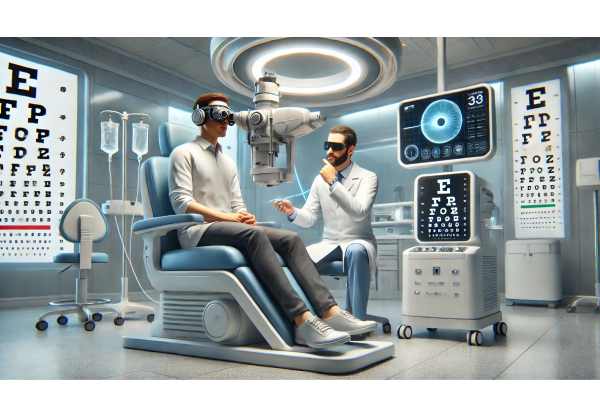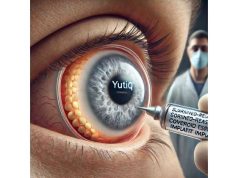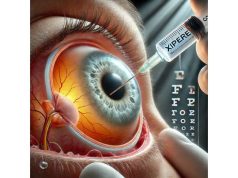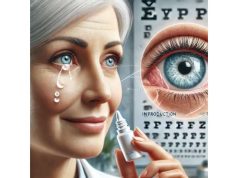
Anisometropia is an ocular condition characterized by a significant difference in refractive power between the two eyes, leading to unequal focus and potential vision problems. This imbalance, if left untreated—especially in children—can result in amblyopia (“lazy eye”), binocular vision disorders, headaches, and eye strain. While some individuals adapt, many require tailored interventions to achieve comfortable, clear vision in both eyes. Effective management may include corrective lenses, advanced optical solutions, surgery, and the latest digital and neuro-visual innovations. This comprehensive guide explores the full spectrum of anisometropia: its causes, clinical impacts, therapies, and the evolving landscape of care.
Table of Contents
- Fundamentals and Epidemiological Insights
- Standard Correction Strategies and Pharmacological Options
- Operative Interventions and Procedural Pathways
- Innovative Solutions and Technological Breakthroughs
- Trials, Pipelines, and Emerging Directions
- Frequently Asked Questions
Fundamentals and Epidemiological Insights
Anisometropia is defined as a difference in the refractive error—such as nearsightedness (myopia), farsightedness (hyperopia), or astigmatism—of at least one diopter between the two eyes. This disparity prevents the brain from merging the two images into a single, clear perception, which can result in suppression of one eye’s image.
Types of anisometropia:
- Simple anisometropia: Only one eye has a refractive error.
- Compound anisometropia: Both eyes are myopic or hyperopic, but to different degrees.
- Mixed anisometropia: One eye is myopic, the other hyperopic.
Pathophysiology:
- In children, the developing brain may suppress input from the more defocused eye, leading to amblyopia and loss of depth perception.
- In adults, the condition often manifests as blurry vision, eyestrain, or trouble with reading and depth cues.
Prevalence and demographics:
- Found in up to 5–7% of children and can occur at any age.
- Risk is higher in those with a family history of refractive errors, prematurity, or certain congenital conditions.
Risk factors:
- Genetics, developmental anomalies, trauma, cataract surgery, or certain syndromes.
Clinical presentation:
- Unilateral blurred vision
- Difficulty with depth perception and 3D tasks
- Eye strain, headaches, or avoidance of near work
- In children, failure to achieve visual milestones
Practical advice:
- Early vision screening—especially in young children—prevents permanent visual impairment.
- Parents should watch for squinting, covering one eye, or head tilting.
Standard Correction Strategies and Pharmacological Options
The primary goal of anisometropia management is to achieve equal focus and prevent or treat amblyopia. Conventional approaches rely on optical correction, sometimes supported by adjunct medical therapies.
Corrective lenses:
- Eyeglasses:
- Most common first-line solution.
- Special high-index or aspheric lenses may reduce thickness and weight for comfort.
- “Aniseikonia” (image size difference) is a challenge; lens design and fitting are critical.
- Contact lenses:
- Offer less image size disparity compared to glasses, making them especially effective in higher degrees of anisometropia.
- Daily disposable or rigid gas-permeable lenses are options based on age and eye health.
Vision therapy:
- Tailored exercises to enhance binocular vision, fusion, and depth perception.
- Computerized or therapist-led programs can be especially helpful in children.
Pharmacologic adjuncts:
- Atropine penalization:
- Used primarily in children with amblyopia who cannot tolerate patching.
- Drops blur vision in the dominant eye, forcing the use of the weaker eye.
- Other medications:
- Research is ongoing into drugs that enhance neural plasticity in older patients.
Patching (occlusion therapy):
- Patching the stronger eye for a prescribed number of hours daily to promote visual development in the weaker eye.
- Consistency and motivation are essential; reward systems can encourage adherence.
Practical tips for daily life:
- Use flexible, child-friendly glasses frames and protective sports goggles.
- Integrate vision exercises into play or school time.
- Monitor for “reverse amblyopia” when patching; regular follow-up is necessary.
Adults:
- May need to gradually adapt to full correction due to long-standing imbalance.
- Occupational and driving adaptations (anti-glare coatings, special filters) can improve comfort.
Operative Interventions and Procedural Pathways
When conventional optical methods are not tolerated or fail to achieve satisfactory binocular vision, surgical and procedural interventions may be considered—especially in adults, or when anisometropia arises from surgical or pathological causes.
Refractive surgical options:
- Laser vision correction (LASIK/PRK):
- Alters the shape of the cornea to equalize refractive errors.
- Can treat both eyes to reach a balanced refractive state.
- Phakic intraocular lenses (IOLs):
- Implantable lenses placed in front of the natural lens, suited for high refractive errors.
- Refractive lens exchange:
- Replaces the natural lens with an artificial IOL, often chosen for older adults or those with early cataract.
Cataract surgery:
- Precise IOL power calculations ensure both eyes are targeted for similar postoperative vision.
- “Blended vision” strategies (targeting one eye for distance, one for near) require careful preoperative planning.
Other interventions:
- Corneal inlays:
- Tiny devices placed in the cornea to adjust refractive power.
- Surgical management of amblyopia:
- Rare, but some centers offer muscle surgery or advanced neural stimulation in selected cases.
Risks and considerations:
- Surgical correction can trigger “anisometropic surprise” if healing or lens positioning is not as predicted.
- Adaptation to new image sizes and clarity may require vision therapy post-op.
Practical pre-surgical steps:
- Trial with contact lenses simulating surgical correction before permanent intervention.
- Full discussion of risks, benefits, and alternatives with a refractive surgery specialist.
Lifelong vigilance:
- Post-surgical patients need routine eye exams to ensure visual balance and ocular health.
Innovative Solutions and Technological Breakthroughs
Recent years have brought rapid advances in the understanding and management of anisometropia, emphasizing individualized solutions, neural adaptation, and digital support.
Latest developments:
- Digital refraction and adaptive optics:
- Advanced tools now measure and correct minute differences in eye focusing power for superior comfort.
- Custom wavefront-guided treatments:
- Tailor corneal laser ablations to the unique optical fingerprint of each eye, minimizing image disparity.
- AI-driven image size matching:
- Software calculates and adjusts corrective options to reduce aniseikonia and optimize binocular vision.
Wearable technology:
- Smart glasses and AR devices:
- Adjust focus and magnification in real time, bridging gaps between eye prescriptions.
- Home-based virtual reality vision therapy:
- Immersive games and training platforms encourage binocular integration and depth perception development in both children and adults.
Genetic and regenerative research:
- Investigations into the genetic underpinnings of anisometropia may inform early detection and intervention.
- Early-stage research explores corneal and lens regeneration to correct refractive errors non-invasively.
Neurovisual innovations:
- Neurofeedback and perceptual learning:
- Digital platforms stimulate neural pathways for better fusion and visual comfort.
- Telemedicine follow-up:
- Remote vision screening and therapy platforms expand access, especially in rural or underserved areas.
Practical tips:
- Discuss new digital and wearable options with your eye care provider.
- Ask about participation in emerging therapy trials if standard treatments have not yielded results.
Trials, Pipelines, and Emerging Directions
The clinical research landscape for anisometropia is evolving, with a focus on enhancing early detection, improving visual outcomes, and personalizing care.
Current research priorities:
- Long-term outcomes of early correction:
- Large population studies are tracking whether early intervention prevents lifelong vision loss and learning difficulties.
- Next-generation corrective devices:
- Development of ultra-light, distortion-minimizing lenses for high anisometropia.
- Biometric and genetic screening:
- Identification of infants and children at risk for anisometropia through routine screenings and genetic profiling.
Therapeutic innovations in the pipeline:
- Drug therapies for neural adaptation:
- Early trials are investigating pharmaceuticals to boost brain adaptation to new optical corrections in adults.
- Advanced neural stimulation:
- Non-invasive devices aimed at rebalancing the brain’s visual processing networks.
Global vision health initiatives:
- Tele-optometry and digital access:
- Mobile vision screening apps and tele-consultations are closing care gaps worldwide.
- Awareness campaigns:
- Education for parents, teachers, and healthcare providers to prioritize early detection and intervention.
Practical engagement:
- Ask your provider about active clinical trials, patient registries, or opportunities to contribute to research.
- Stay informed about updates in local and global vision health programs.
What’s ahead:
- Fully personalized, AI-guided treatment pathways from infancy through adulthood.
- A shift toward prevention and neural support, not just optical correction.
Frequently Asked Questions
What is the best way to correct anisometropia?
Contact lenses are often the preferred solution, especially for higher differences, as they minimize image size disparity. For children, glasses and vision therapy are key to preventing amblyopia. Surgery may be considered in selected cases.
Can anisometropia cause lazy eye?
Yes. If left untreated in childhood, the brain may suppress input from the blurrier eye, resulting in amblyopia (lazy eye) and potentially lifelong vision loss. Early correction and therapy are critical.
Is surgery safe for correcting anisometropia?
Refractive surgery (like LASIK, PRK, or lens implants) can be effective and safe in adults after thorough evaluation. For children, surgery is generally reserved for cases where other methods fail.
Do children outgrow anisometropia?
Anisometropia rarely resolves on its own and often worsens with growth. Early detection and regular eye exams help manage progression and prevent complications.
How does anisometropia affect daily life?
It can cause blurred vision, headaches, eye strain, reading difficulties, and poor depth perception. Proper correction and adaptation help most people lead normal, comfortable lives.
Can adults adapt to correction after years of anisometropia?
Adaptation is possible but may take longer, particularly with large differences. Gradual introduction of correction, combined with vision therapy, can improve comfort and visual performance.
Disclaimer:
This guide is for informational purposes only and should not substitute for professional medical advice, diagnosis, or treatment. Consult your eye care specialist for personalized recommendations and follow-up.
If you found this article helpful, please share it on Facebook, X (formerly Twitter), or your preferred platform, and follow us for more up-to-date eye health guidance. Your support helps us continue bringing you quality, evidence-based resources!










